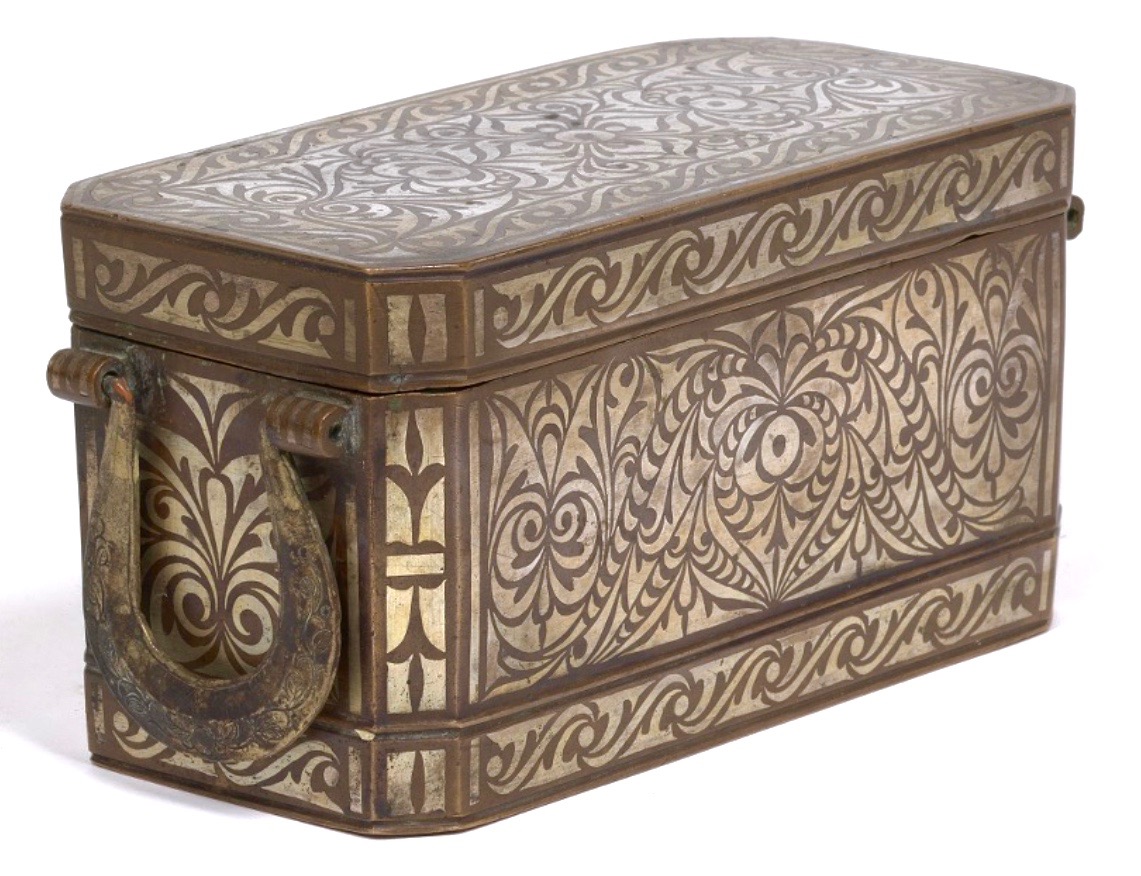

Title: Mindanao Cast Bronze and Silver Betel Nut Box
Shipping: $30.00
Artist: N/A
Period: Unassigned
History: N/A
Origin: Southern Asia > Philippines
Condition: Museum Quality
Item Date: N/A
Item ID: 6766
Absolutely beautiful! This is an incredibly large and heavy Silver and bronze box. Mindanao Cast Bronze and Silver Betel Nut Box 9" x 4" x 4 ½" / 19th c., Philippines, rectangular with canted corners and hinged lid, overall floral design, the interior fitted with four conforming hinged lidded compartments. Carved horseshoe shaped handles. Condition: Good, some wear from age, oxidation. The box has virtually no inlay loss, The Betel nut is a mild stimulant that is chewed throughout Asia. / The betel palm ( found primarily in Asian countries ) yields a seed known as the betal nut. The dark nut is often wrapped in a betel leaf and flavored with lime. Menginang tradition or chewing betel nut is widespread among Indonesian ethnic groups, especially among the Javanese, Balinese and Malay people; dating back to more than 3000 years.[15] Records of travelers from China showed that betel and areca had been consumed since the 2nd century BCE. It is a tradition in South India and nearby regions to give two Betel leaves, areca nut (pieces or whole) and Coconut to the guests (both male and female) at any auspicious occasion. Even on a regular day it is the tradition to give a married woman, who visits the house, two Betel leaves, areca nut and coconut or some fruits along with a string of threaded flowers. This is referred to as tambolam. In a 16th-century cookbook, Nimmatnama-i Nasiruddin-Shahi, describes Ghiyas-ud-din Khalji, the Sultan of Mandu (r. 1469–1500), watches as tender betel leaves of the finest quality are spread out and rosewater is sprinkled on them, while saffron is also added. An elaborate betel chew or paan would contain fragrant spices and rose preserves with chopped areca nuts.
Paan (from Sanskrit parṇa meaning "leaf" is a preparation combining betel leaf with areca nut widely consumed throughout South Asia, Southeast Asia and Taiwan. It is chewed for its stimulant and psychoactive effects. After chewing it is either spat out or swallowed. Paan has many variations. Slaked lime (chunnam) paste is commonly added to bind the leaves. Some South Asian preparations include katha paste or mukhwas to freshen the breath.
Paan has been part of the indigenous culture in the Philippines. It is commonly and simply referred to as ngangà in Tagalog and mama or maman in Ilokano. Ngangà literally means "to chew/gnaw". Nowadays, it is mostly popular among the inhabitants of the Cordilleras, among the Lumads of Mindanao, and among lowland barrio folks elsewhere in the Philippines.
Scientific evidence that chewing betel quids and areca nut is carcinogenic to humans. The main carcinogenic factor is believed to be areca nut.